319th Operations Group
| 319th Operations Group | |
|---|---|
|
Emblem of the 319th Operations Group | |
| Active | 1942–1945; 1946–1949; 1949–1951; 1955–1957; 1991—present |
| Country | United States |
| Branch | United States Air Force |
| Part of | 319th Air Refueling Wing |
| Garrison/HQ | Grand Forks AFB, North Dakota |
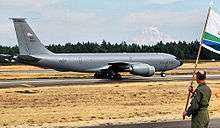
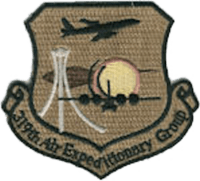
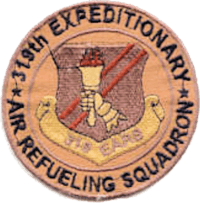
The 319th Operations Group (319 OG) is the flying component of the 319th Air Refueling Wing, assigned to the United States Air Force Air Mobility Command. The group is stationed at Grand Forks Air Force Base, North Dakota.
The group's predecessor World War II unit, the 319th Bombardment Group was the first Martin B-26 Marauder group in the Mediterranean Theater of Operations during the war. The group received two Distinguished Unit Citations during the war. In 1945, the group was re-equipped with the B-25 in combat in the MTO before returning to the US to transition to the Douglas A-26 Invader. After re-training thr groupwas deployed to Okinawa, where it flew combat missions over China as part of Seventh Air Force against Imperial Japanese forces until the war's end.
One of the original Mercury Seven astronauts, Donald Kent “Deke” Slayton, flew A-26s from Okinawa as a part of the group's 438th Bomb Squadron in 1945.
Overview
The 319 OG (Tail stripe: Grand Forks) provides air refueling of combat and support aircraft around the world through its global mobility operations flying KC-135R/T tankers.
Components
The group consisted of the following squadrons:
- 319th Operations Support Squadron
- 319th Expeditionary Air Refueling Squadron (Group components deployed to Central Command)
- 905th Air Refueling Squadron (Blue tail stripe)
- 906th Air Refueling Squadron (Yellow tail stripe)
- 912th Air Refueling Squadron (White tail stripe)
History
- See the 319th Air Refueling Wing for additional history and lineage
World War II
![]() Media related to United States Army Air Forces 319th Bombardment Group at Wikimedia Commons
Media related to United States Army Air Forces 319th Bombardment Group at Wikimedia Commons

The 319th Bombardment Group trained in Louisiana in B-26 Marauders and after completing initial training, the group reported in October and November 1942 to England for staging to the Mediterranean theater of operations, where it was assigned to the Twelfth Air Force.
After it moved to Algeria as the first Martin B-26 Marauder unit in that theater, arriving with just 15 aircraft and losing group commander Col. Alvord Rutherford over France en route, the 319th BG entered combat for the first time on 28 November, bombing and strafing warehouses, docks, and railroad yards at Sfax in Tunisia. From then to March 1943, the group bombed German and Italian targets in Tunisia and Libya, including airfields and enemy shipping along the Mediterranean Coast. The 319th trained in French Morocco from March, then returned to combat in June 1943, attacking enemy targets on Italian island in the Mediterranean, including Sicily, Sardinia, and Pantelleria. From bases in Algeria and Tunisia, the group supported the Allied invasion of Italy, bombing bridges and marshalling yards during the late summer and early autumn of 1943. In November, it moved to Sardinia, to strike Axis targets in central Italy. Early in 1944, the 319th supported Allied ground forces as they advanced in the Cassino and Anzio areas. Later in the year, using North American B-25 Mitchell bombers the group attacked German supply lines in northern Italy, bombing bridges, marshalling yards, and roads. In March, it earned two Distinguished Unit Citations for raids on marshalling yards in Rome and Florence that damaged enemy communications without destroying cultural monuments. For supporting the Allied ground advance in Italy during April, May, and June 1944, the group earned the French Croix de Guerre. During the summer, it bombed bridges over the Po River in northern Italy using B-25 bombers to block the stream of German supplies and reinforcements going southward. The 319th Bombardment Group supported the invasion of southern France in August 1944 by attacking coastal batteries, radar stations, and bridges. From Corsica, it hit railroad bridges in Northern Italy and late in the year attacked railroad lines through the Brenner Pass that connected Germany and Austria with Italy.
In January 1945, the 319th returned to the United States, where it began to train with Douglas A-26 Invader aircraft for operations in the Pacific Theater. Between May and July 1945, the group moved by ship to Okinawa, and on 16 July flew its first mission against Japan. From then until the end of the fighting in early August, the 319th attacked enemy targets such as airfields and industrial centers on Kyūshū and occupied Shanghai area of China, and shipping around the Ryukyu Islands and in the East China Sea. In November and December 1945, the group returned to the United States.
Cold War
During the Truman and Eisenhower administrations, the 319th served three periods in the continental United States as a reserve organization. It was inactivated in 1957 when its operational squadrons were assigned directly to its parent wing as a result of the Air Force tri-deputate reorganization.
Modern era
The group was reactivated in on 1 September 1991 as the 319th Operations Group and assigned to the 319th Bomb Wing as part of the "Objective Wing" concept adapted by the Air Force. The 319th OG was bestowed the lineage, honors and history of the 319th Bombardment Group, Heavy and its predecessor units.
The 319th Operations Group took control of operational units of the 319th Bomb Wing at Grand Forks AFB, ND. At that time it was equipped with B-1B and KC-135 aircraft. For a brief period between September 1992 and October 1993, the Group lost its refueling mission. However, in October 1993, the 319th Wing was redesignated as an Air Refueling Wing and its bombardment squadron was reassigned. Over the next year, the group gained four air refueling squadrons equipped with KC-135R/T aircraft. It supported worldwide Tanker Task Forces, as well as, combat operations in Southwest Asia, Central Europe, and antidrug operations in Central America by constantly deploying elements to provide air refueling for combat aircraft, 1993–present.
319th Air Expeditionary Group

The 319th Air Expeditionary Group is a provisional unit allocated to Air Mobility Command for activation or inactivation anytime after 11 September 2001. It was deployed to a makeshift tent city somewhere in the arid desert of Southwest Asia. From the start of air operations over Afghanistan 7 October, by 2 November 2001 the 319th Air Expeditionary Group [319th AEG] had flown over 150 sorties and more than 1050 hours; pumping over 1.4 million US gallons (5,300 m3) of gas into more than 450 planes.
Keeping jets aloft and providing fuel to the fight – it’s the main reason the 319th Air Expeditionary Group Aircraft Generation Squadron is deployed to ensure the jets keep flying and are fully prepared to support the air campaign against terrorism. Consisting of crew chiefs, aircraft specialists, maintenance specialists and various support agencies, the AGS is composed exclusively of personnel from Grand Forks AFB.
Refueling by the Grand Forks Air Force Base's 319th Air Refueling Group is the mission of Base X in Oman. The mission, going on since early in the Afghan war, has become workaday. Base X serves as the forward operating location for US air refueling aircraft in the Middle East. US bombers, crucial during Operation Anaconda in March, are just some of the planes that receive mid-air refueling from KC-135 tankers stationed there. 'Base X' is likely to have been Masirah Air Base, where the RAF and USAF have long had facilities.
Lineage
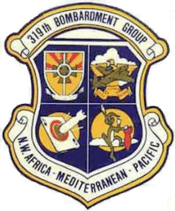
- Established as 319th Bombardment Group (Medium) on 19 June 1942
- Activated on 26 June 1942
- Redesignated: 319th Bombardment Group, Medium on 20 August 1943
- Redesignated: 319th Bombardment Group, Light on 3 February 1945
- Inactivated on 18 December 1945
- Activated in the Reserve on 27 December 1946
- Inactivated on 2 September 1949
- Activated in the Reserve on 10 October 1949
- Ordered to active duty on 10 March 1951
- Inactivated on 22 March 1951
- Redesignated: 319th Fighter-Bomber Group on 12 April 1955
- Activated in the Reserve on 18 May 1955
- Inactivated on 16 November 1957
- Redesignated: 319th Bombardment Group, Heavy on 31 July 1985 (Remained inactive)
- Redesignated: 319th Operations Group on 29 August 1991
- Activated on 1 September 1991
Assignments
|
|
Components
- 46th Bombardment (later, 46 Bomb) Squadron: 16 April 1947 – 2 September 1949; 10 October 1949 – 22 March 1951; 1 September 1991 – 1 October 1993
- 50th Bombardment Squadron: 16 April 1947 – 2 September 1949; 10 October 1949 – 22 March 1951
- 51st Bombardment Squadron: 8 July 1947 – 2 September 1949; 10 October 1949 – 22 March 1951
- 59th Bombardment Squadron: 8 July 1947 – 2 September 1949; 10 October 1949 – 22 March 1951
- 437th Bombardment Squadron: 26 June 1942 – 18 December 1945
- 438th Bombardment Squadron: 26 June 1942 – 13 December 1945
- 439th Bombardment Squadron: 26 June 1942 – 18 December 1945
- 440th Bombardment Squadron: 26 June 1942 – 18 December 1945
- 905th Air Refueling Squadron: 1 September 1991 – 1 June 1992; 1 October 1993 – 31 December 2010
- 906th Air Refueling Squadron: 30 January 1994 – 2 October 2009
- 911th Air Refueling Squadron: 29 April 1994 – 30 June 2007
- 912th Air Refueling Squadron: 1 April 1994 – 1 October 2010
Stations
|
|
Aircraft assigned
- B-26 Marauder, 1942–1944
- B-25 Mitchell, 1944
- A-26 Invader, 1945
- B-1B Lancer, 1991–1993
- C-12 Huron 1991–1995
- KC-135 Stratotanker, 1991–1992, 1993–2010
See also
- List of units using the B-26 Marauder during World War II
- 514th Air Service Group World War II support organization for the group
References
![]() This article incorporates public domain material from the Air Force Historical Research Agency website http://www.afhra.af.mil/.
This article incorporates public domain material from the Air Force Historical Research Agency website http://www.afhra.af.mil/.
- Maurer, Maurer, ed. (1983) [1961]. Air Force Combat Units of World War II (PDF) (reprint ed.). Washington, DC: Office of Air Force History. ISBN 0-912799-02-1. LCCN 61060979.
- Ravenstein, Charles A. (1984). Air Force Combat Wings, Lineage & Honors Histories 1947-1977 (PDF). Washington, DC: Office of Air Force History. ISBN 0-912799-12-9.

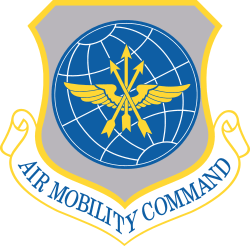

.svg.png)
.svg.png)